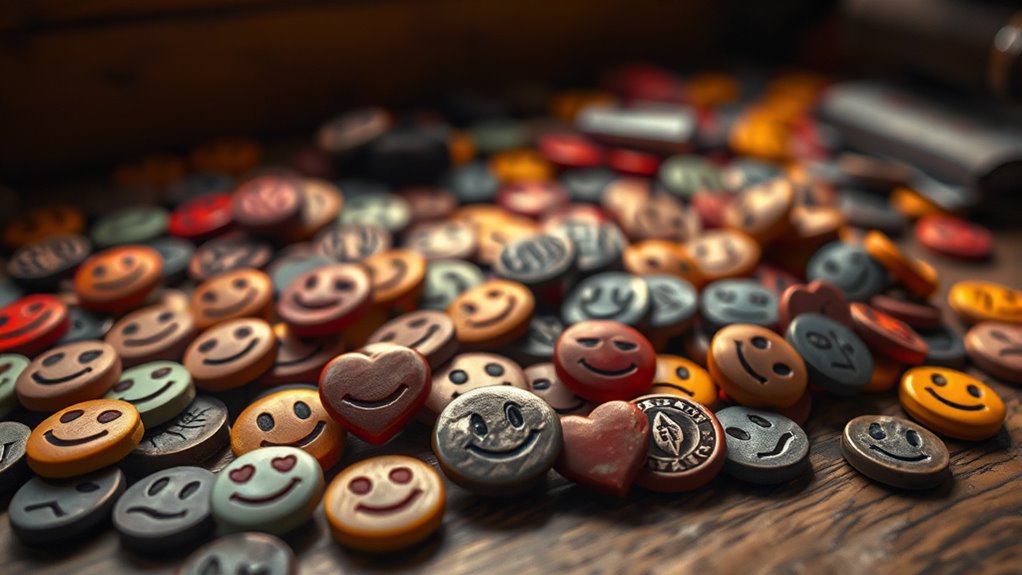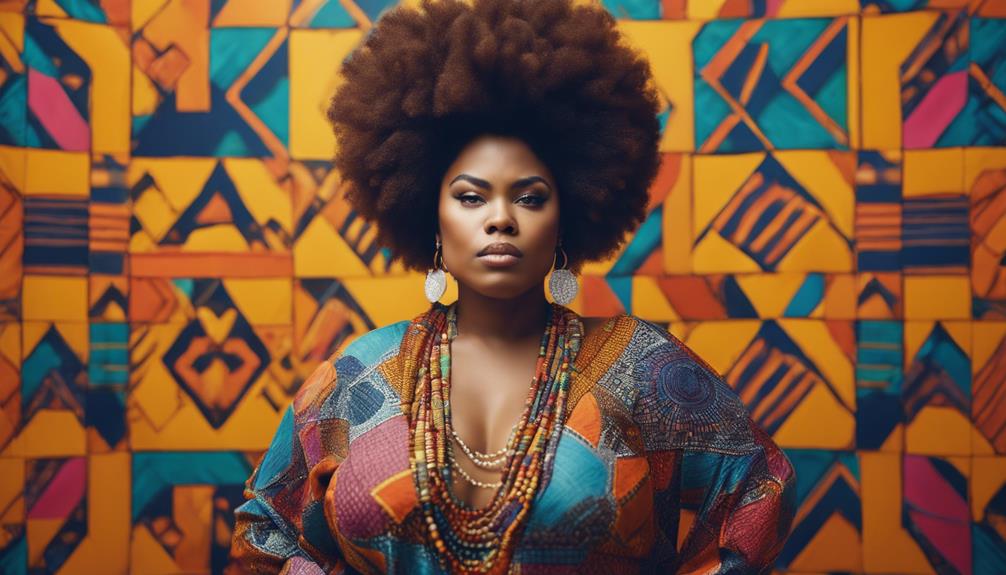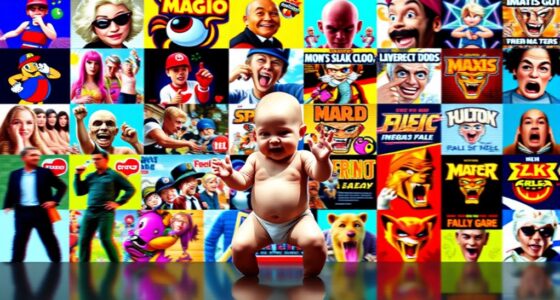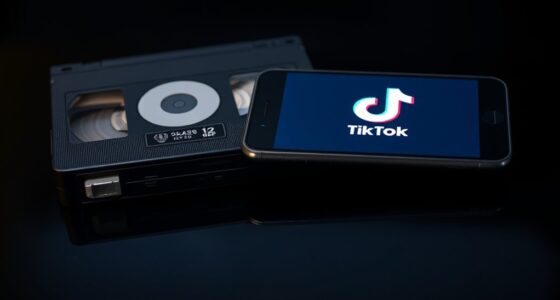The secret history of emojis reveals how they evolved from simple Japanese symbols in the late 1990s to a universal language that conveys emotions across cultures. While they’re standardized globally, many emojis carry hidden meanings shaped by cultural perceptions. For instance, a thumbs-up can be positive in one place but offensive elsewhere. By understanding these nuances and the cultural influences behind them, you can uncover deeper messages behind everyday symbols—there’s much more to discover beneath the surface.
Key Takeaways
- Emojis originated in Japan in the late 1990s to add emotional context to digital communication.
- Standardized by the Unicode Consortium, emojis are recognized worldwide, but meanings vary culturally.
- Cultural perceptions influence how emojis like 👍, 🌹, and 🙏 are interpreted across different regions.
- Many emojis carry hidden, culturally-specific meanings, such as political messages or social norms.
- Understanding these layered meanings enhances cross-cultural communication and reveals the deeper history of emojis.
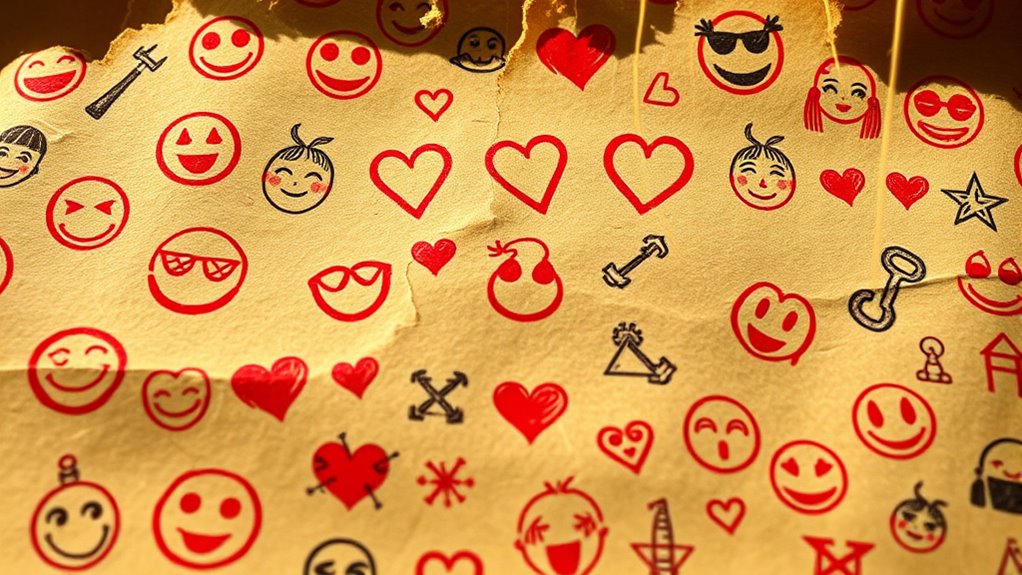
Emojis have become a universal language, transforming the way we communicate online and in texts. They aren’t just colorful icons; they’re the result of an intriguing emoji evolution that reflects our changing society. Over the years, emojis have grown from simple smiley faces to complex symbols representing a wide range of emotions, objects, and ideas. This evolution isn’t random—it’s influenced by cultural interpretations that shape how different groups perceive and use these icons. For example, a thumbs-up might be a positive gesture in many Western countries, but in some Middle Eastern cultures, it can be offensive. Recognizing these cultural nuances is essential if you want to understand the true meaning behind certain emojis.
Emojis evolved from simple icons to cultural symbols influencing global communication.
As you explore the history of emojis, you’ll see that their development was driven by a desire to bridge language barriers and convey emotions more efficiently. Originally, emojis started as Japanese mobile phone symbols in the late 1990s and early 2000s, designed to add emotional context to text messages. Over time, tech companies and standards organizations, like the Unicode Consortium, standardized these symbols, making them universally recognizable. This standardization allowed emojis to transcend language boundaries, but it also led to variations in interpretation based on cultural backgrounds. What might seem innocent or humorous in one culture could carry a different connotation elsewhere, adding layers of complexity to their use.
The hidden meanings behind emojis often lie in their cultural interpretations. For instance, the 🌹 rose emoji can symbolize love and romance in Western cultures, but in some Middle Eastern and Asian countries, it might be seen as a symbol of beauty or even political significance. Similarly, the 🙏 folded hands emoji is often used to express gratitude or prayer, but in certain Asian cultures, it’s more commonly associated with greeting or respect. These subtle differences highlight how emojis are not just universal symbols but are also deeply rooted in cultural contexts. When you use emojis, you’re participating in a complex web of cultural communication, often without realizing it. Moreover, cultural interpretations of emojis continue to evolve as global connectivity increases and societies become more diverse.
Understanding the history and hidden meanings of emojis can help you communicate more thoughtfully. By appreciating their emoji evolution and cultural interpretations, you become more aware of how your messages might be received across different communities. Emojis are more than just playful icons—they’re a reflection of cultural identities and social norms. The next time you pick an emoji, think about its journey and the stories it might be telling beyond its surface. Doing so enriches your digital conversations and deepens your understanding of global communication.
Frequently Asked Questions
How Did Emojis Originate Across Different Cultures?
You might wonder how emojis originated across different cultures. They stem from diverse cultural symbolism and have a rich historical evolution, reflecting unique expressions worldwide. Different societies used symbols to communicate emotions or ideas long before digital emojis. This cultural diversity influenced emoji development, blending traditional symbols with modern technology. As a result, emojis now serve as universal visual language, capturing global human experiences and emotions in a simple, relatable way.
Are There Emojis With Secret or Coded Messages?
Think of emojis as tiny secret agents, whispering hidden codes through digital screens. Yes, some emojis carry covert messages, like a clandestine language only certain eyes can decipher. People use these symbols for hidden code, conveying messages beneath the surface. You might miss the secret unless you look closely, but for those in the know, emojis become a playful, covert communication tool, turning simple icons into a digital cipher.
How Do Emoji Meanings Vary Globally?
You’ll notice that emoji meanings can vary widely around the world due to cultural interpretations and regional variations. In some places, a symbol might carry a positive or neutral connotation, while in others, it could be offensive or misunderstood. These differences influence how you use emojis in your messages, making it important to take into account your audience’s cultural background to avoid miscommunication and ensure your intent comes across clearly.
What Future Emoji Trends Are Anticipated?
Imagine emojis as tiny ambassadors shaping the future of communication. You’ll see them evolve with trends like emojis in branding and emoji-based marketing, making messages more personal and engaging. Expect more diverse symbols, enhanced interactivity, and AI-driven customization to reflect individual identities. These trends will deepen emotional connections, transforming how brands connect with audiences. Stay tuned, because emojis will continue to unseal new ways of expressing what words alone can’t capture.
Can Emojis Influence Social or Political Movements?
You can see how emojis influence social or political movements by enhancing digital activism, making messages more immediate and emotional. When used effectively, they rally support and draw attention to issues. However, emoji censorship can hinder this impact, restricting expression and potentially silencing voices. Overall, emojis serve as powerful tools for social change, but their influence depends on open communication and the fight against censorship.
Conclusion
As you’ve seen, emojis aren’t just cute symbols—they carry hidden stories and emotions, often revealing more than words can say. Maybe that’s why you’ve noticed a wink or a thumbs-up at just the right moment, feeling that unspoken connection. It’s no coincidence; emojis have become our silent language, bridging gaps and sharing feelings in ways words never could. So next time you send one, remember—it’s more than just an emoji, it’s a secret message waiting to be discovered.

